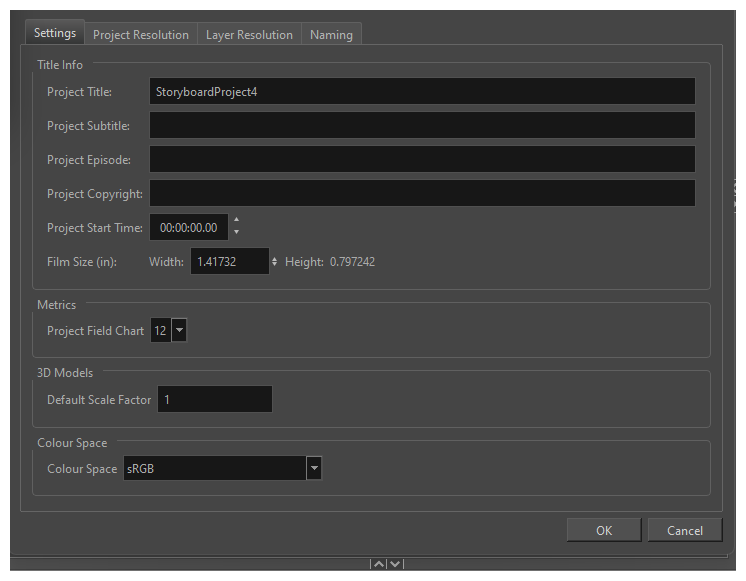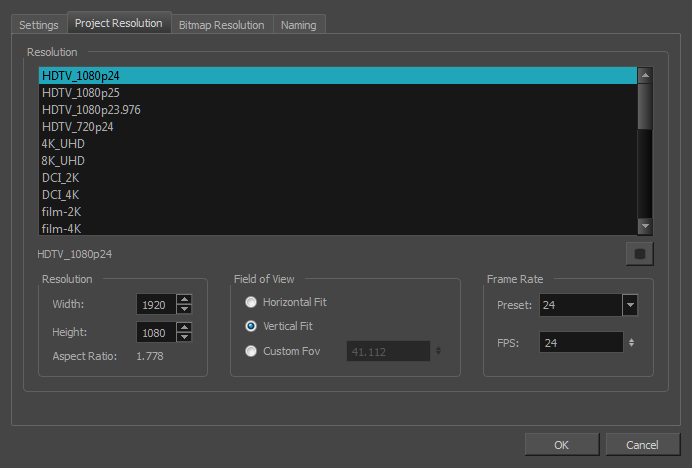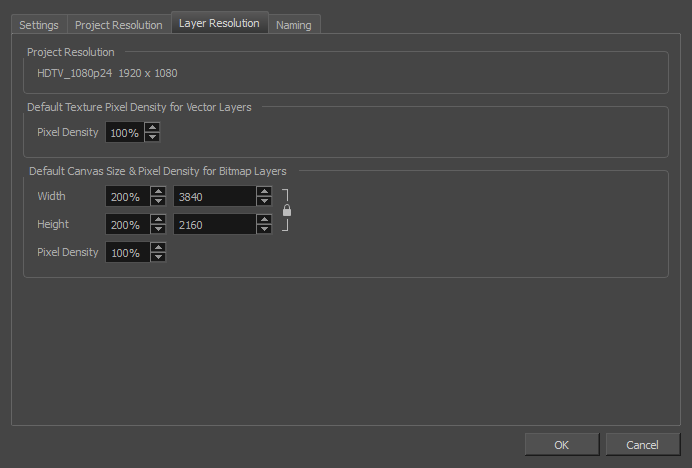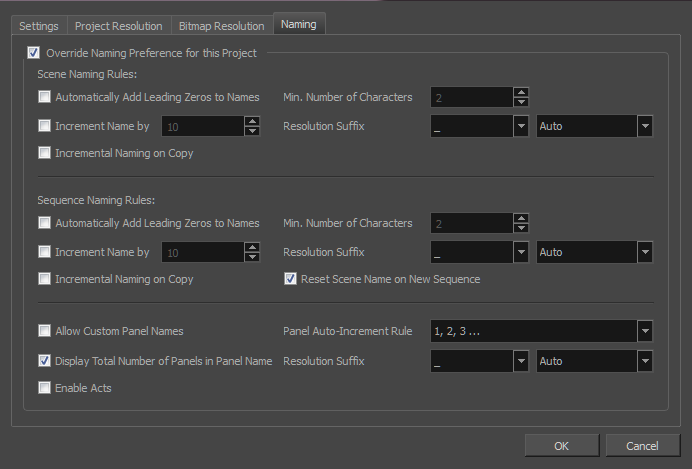Project Properties Dialog Box
The

- Do one of the following:
| ‣ | Select Storyboard > |
| ‣ | Press Alt + Return. |
In the Settings tab, you can define the project naming scheme and start time for the current project.

| Parameter | Description |
|
Title Info
|
Project Title: By default, the Project Name already appears is this field if no project title was entered during the creation of this project. The Project Name is the name of the Storyboard Pro project file. The Project Title is the title that will appear in all PDF renders. They can, and often should, be the same. NOTE Special characters (!"/$) cannot be used for project names because they interfere with the operating system. However, they can be used in the project title.
|
|
Project Subtitle: The name of the project subtitle which appears in the proper places in all PDF renders. |
|
|
Project Episode: The episode number. If you want the word “Episode” to appear next to the number, you must include it in the field as well. The information entered in this field will appear after the Project Subtitle in all PDF renders. |
|
| Project Copyright: The copyright date. This can be the month and year or just the year. This information will appear at the bottom of the page in all PDF renders. | |
| Project Start Time: This time is important when generating an EDL (Editing Decision List) of your project. EDLs are generally used by third party editing software, such as Final Cut Pro. The EDL determines how the panels of your project are distributed in the timeline of the third party software. The numerical value you enter in this field also appears as the start time in the Timeline view. | |
|
Film Size: When working on a 3D scene, the film size determines the focal length of the camera. You should use the same value as that used in the 3D software used to create the 3D elements. A value of 1.417 is equivalent to 35mm film. |
|
|
Metrics |
Project Field Chart: Sets the field standard for the project. |
|
3D Models |
Default Scale Factor: The default scale factor to apply to a 3D model when it is imported into your |
| Colour Space | Colour SpaceThe colour space that each layer will be converted to before all elements in the scene are composited together along with your scene's effects. The following colour spaces are available for your project:
|
In the Project Resolution tab, you can define the project resolution, aspect ratio

| Parameter | Description |
|
Resolution |
Lets you define the project resolution. Your project resolution should match the format of the production for which you are creating the storyboard. |
|
HDTV: High Definition Television delivers a higher quality image than standard television because it has twice the standard number of scanning lines per frame. To take advantage of the superior quality, your output device must be compatible with HDTV technology to make this resolution setting useful. |
|
|
HDTV_Vertical: The "vertical resolution" of HDTV_Vertical refers to how the drawing grid is fit into the camera frame. When working with 12 or 16 field drawing grids, the grid is a different aspect ratio from the camera frame. When you fit vertically, you fit the grid with the top and bottom of the camera frame. NOTE The HDTV_Vertical format is ideal when importing images into an HD project.
|
|
| Mobile_Horizontal: | |
| Mobile_Vertical: | |
| Game_512: | |
|
film-1.33: Applies to a wide screen film format that conforms to the standard 4:3 pixel aspect ratio. |
|
|
|
|
|
film-1.66_Vertical: This is essentially the same as film-1.66. Refers to how the drawing grid is fit into the camera frame. When working with 12 or 16 field drawing grids, the grid is a different aspect ratio from the camera frame. When you fit vertically, you fit the grid with the top and bottom of the camera frame. NOTE The film-1.66_Vertical view is ideal for importing images into film projects.
|
|
|
|
|
|
|
|
|
|
|
|
Resolution |
Width: The width of the project, in pixels. |
|
Height: The height of the project, in pixels. |
|
| Aspect Ratio: The aspect ratio describes the number of pixels wide the project is divided by the height. Storyboard Pro always works with square pixels. An aspect ratio of 1:1 indicates that the camera frame is square, and has the same number of pixels defining the width as it does defining the height. The aspect ratio is defined automatically when you enter values for the width and height of the camera frame. | |
|
Field of View |
Defines how the camera frame fits with the drawing grid in your scene. When working in 3D, a different custom FOV might be more common, so this can be set here as the default FOV for the scenes in your project. The FOV can be adjusted for individual 3D scenes, in order to switch out the camera lens. |
| Horizontal Fit: Fits the drawing grid to the width of the camera frame. | |
|
Vertical Fit: Fits the drawing grid with the top and bottom of the camera frame. |
|
|
Frame Rate |
Lets you set the frame rate for the project. The higher the frame rate, for example 30 fps, the smoother your animation will look, but the heavier it will be. The lower the frame rate, for example 12 fps, the choppier your animation may look, but the lighter it will be. |
In the

| Parameter | Description |
|
Project Resolution |
The project resolution of the project, displayed for reference. |
| Default Texture Pixel Density for Vector Layers | |
|
Pixel Density |
Determines the amount of pixels to store in textured brush strokes for each pixel that displays when the drawing is not zoomed in or scaled up. For example, at 100%, zooming in or scaling up textured brush strokes will make them lose texture quality. If set to 200%, textured brush strokes can be zoomed in or scaled up until they're twice their original size without losing picture quality. |
| Default Canvas Size & Pixel Density for Bitmap Layers | |
|
Width |
The default width of the canvas when creating a bitmap drawing layer. The percentage is relative to the width of the |
|
Height |
The default height of the canvas when creating a bitmap drawing layer. The percentage is relative to the height of the |
|
Lock/Unlock |
When enabled, changing either the Width or the Height property will update the other property to preserve their proportions. |
|
Pixel Density |
Determines the amount of pixels to store for each pixel that displays on the screen when the drawing is not zoomed in or scaled up. For example, at 100%, zooming in or scaling up a bitmap drawing will make it lose picture quality. If set to 200%, bitmap drawings can be zoomed in or scaled up until they're twice their original size without losing picture quality. |
In the Naming tab, all options affect the Panel window. The changes you make in this tab override your Storyboard Pro preferences and affect the current project only. Your default preferences remain in effect for any new projects you create.

| Parameter | Description |
| Override Naming Preference for this Project | When selected, current preferences for this project are overridden, and all the options on this tab become active. |
|
Scene/Sequence Naming Rules |
Automatically Add Leading Zeros to Names: Automatically adds a zero before the scene or sequence name. |
|
Increment Name By: |
|
| Incremental Naming on Copy: | |
|
Min. Number of Characters: Determines the minimum number of characters the scene names will contain when using leading zeros. |
|
|
Resolution Suffix: Lets you set the suffix pattern to use when a suffix is added to a new scene when the name is already in use. You can choose the punctuation mark preceding the suffix from the first drop-down menu:None: Suffix appears immediately following the name of the scene. For example: 12A._: Suffix appears after an underscore. For example: 12_A..: Suffix appears after a period. For example: 12.A.You can choose which type of suffix to use:Auto: Uses an upper case alphabetical suffix. Once the suffix reaches Z, it will start again at A, preceeded by a number. Example: 12_A, 12_B, (...), 12_1A, 12_1B, and so on.Numerical: Uses a numerical suffix. For example: 12_1, 12_2, and so on.Uppercase: Uses an upper case alphabetical suffix. For example: 12_A, 12_B, and so on.Lowercase: Uses a lower case alphabetical suffix. For example: 12_a, 12_b, and so on. |
|
|
Reset Scene Name on New Sequence: By default, this option is enabled. Whenever you create a new sequence, the scene naming scheme is reset. For example, the naming will be as follows: Seq 1, Scene 1, Seq 1, Scene 2, Seq 2, Scene 1. When disabled, the scene number always increments. For example, Seq 1, Scene 1, Seq 1, Scene 2, Seq 2, Scene 3. |
|
|
Allow Custom Panel Names: Activates the Panel field so you can enter in a custom name for all panels. |
|
|
Display Total Number of Panels in Panel Name: Displays a counter at the end of the Panel field which indicates the total number of panels in the selected panel’s scene. |
|
|
Enable Acts: Displays the Act field, along with the Act number. |
|
|
Panel Auto-increment Rule: By default, panel names are named using numbers. This preference allows you to select a different naming rule, most of which use letters instead:
|
|
|
Resolution Suffix: Lets you set the suffix pattern to use when a suffix is added to a new scene when the name is already in use. You can choose the punctuation mark preceding the suffix from the first drop-down menu:None: Suffix appears immediately following the name of the scene. For example: 12A._: Suffix appears after an underscore. For example: 12_A..: Suffix appears after a period. For example: 12.A.You can choose which type of suffix to use:Auto: Uses an upper case alphabetical suffix. Once the suffix reaches Z, it will start again at A, preceeded by a number. Example: 12_A, 12_B, (...), 12_1A, 12_1B, and so on.Numerical: Uses a numerical suffix. For example: 12_1, 12_2, and so on.Uppercase: Uses an upper case alphabetical suffix. For example: 12_A, 12_B, and so on.Lowercase: Uses a lower case alphabetical suffix. For example: 12_a, 12_b, and so on. |